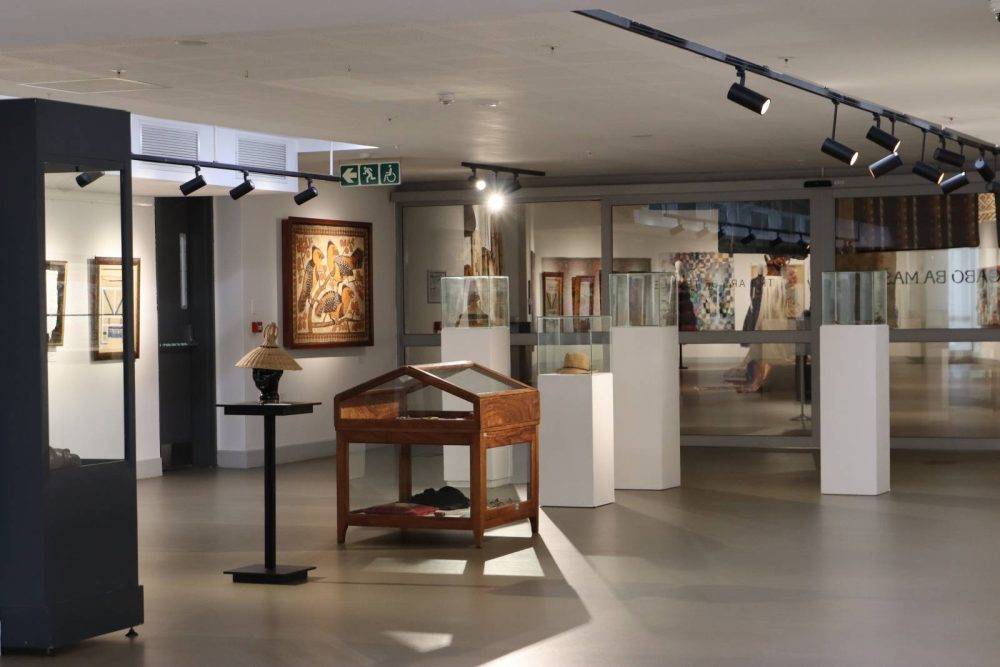
A stitch in time: The Bokgabo ba Mašela: Art of Textiles exhibition, which is on at the University of Pretoria Museums until 15 October, includes works using embroidery, quilting and other forms of needlework.
As you enter the Javett Art Centre at the University of Pretoria, you see a towering wooden sculpture standing there, making its presence known.
It is a beautifully crafted sculpture commemorating the women who marched to the Union Buildings in Pretoria in 1956 to protest the oppressive, inhumane pass laws.
It is symbolic of the perpetual silencing and “invisibilising” of women and their role in society.
Crafted several years ago by artist Noria Mabasa, the sculpture languished in storage in a government museum — an altogether too familiar narrative. Like so many contributions made by women, it remained hidden for too long.
Indian scholar Gayatri Spivak’s concept of “the subaltern” highlights the plight of women — neglected and impeded, mocked and constrained by colonial and patriarchal structures.
Refusing to properly commemorate women’s contributions in our historical archives and at memorial sites is a form of mockery and undermines both their labour and the sacrifices they made to the struggle for the liberation of the oppressed.
The University of Pretoria Museums is hosting an exhibition titled Bokgabo ba Masela: Art of Textiles, curated by Uthando Baduza.
Aligned with the reflection above about the silencing of women, the exhibition attempts to flip the script on how we see women and their contributions in history and in our imagination of the future.
It highlights the role of textiles and their political and social relevance as we think about materials and design.
In the African context, textiles are used symbolically to communicate wisdom, strength and community.
Textiles have also been used to convey messages, proverbs and stories, serving as a visual language.

Of course, we cannot leave the complex colonial intervention out of the conversation — and, as one walks through the exhibition, this colonial gaze glares at you.
Africa’s interaction with Europe dates back centuries, beginning with commercial trading in textiles and expanding during the transatlantic slave trade. This relationship was inherently exploitative.
This complex colonial history continues to affect our everyday experiences, including in art spaces. The exhibition explores this connection of history to the present and complicates how we see, imagine and reflect on the role of textiles in our lives.
It has many embroidered pieces on display, highlighting the power of needle and thread to tell complicated stories of our everyday lives.
Needlework is expressed in varied ways at the exhibition — embroidery, quilting, threading — and these artistic tools are used to show how women, in particular, can artistically reflect on their lives and on the world around them.
Textiles have been used to narrate experiences of trauma and loss, as can be seen in the Keiskammahoek Guernica, as well as of peace, beauty, survival and hope, as explored in the Mapula embroidery piece.
The exhibition shows how visual narratives can serve as sites of memory, of remembering, of commemoration, of holding and making histories visible, and of healing.
In various parts of the world, embroidery, quilting and needlework more generally have for a long time been reserved for and perceived as women’s duties.
However, textile work shows how the political is enmeshed with the personal and the domestic space. It is a form of political resistance that allows people to construct ways of meaning-making amid conflict and post-conflict situations.
Textiles offer a means of telling biographical stories as well as space for the reinvention of lives, as one sees at the exhibition. For example, the colourful, wall-to-wall University of Pretoria quilt offers a reimagining of campus space, attending to what is hoped and aspired for.
Textile works provide glimpses into the lives of individuals who might not have left written records of their lives.
The show further highlights how artistic images can represent people’s reflections on everyday experiences, experiences that are sometimes seen as banal but might also reflect the injustices that confront people daily. It is not just about the work of art itself, but what it represents as social commentary and as a holder of history and an imagined future.
Much of the work exhibited is crafted by women, who have been relegated to the peripheries of society, therefore, their narratives should be seen not only as beautiful, colourful artworks but as sources of knowledge and as repositories of lived wisdom.
Textile works highlight layers of history, lived experience and culture. This is illustrated by the traditional Ndebele beaded cloths on display, which offer an intergenerational telling of life stages and rites of passage.
The varied works displayed at the museum challenge us to reimagine the role of art history as a discipline and the need for reimagining how we define, theorise and decide on what counts as knowledge and as art, and ultimately, what belongs to the area of art history.
The exhibition allows the viewer to reflect on how we think about textiles and their role in narrating our lives, in connecting the past to the present and in allowing space for the flow and co-existence of the interpretation of the everyday.
It serves as an invitation to a journey through the living, breathing, meaningful side of art history where works offer space for meaning and movement and where art is showcased in ways that reveal diversity in how we imagine textile, materiality, and design.
Its boldness offers us a chance to critically reflect, question and collectively contribute towards a more meaningful understanding of art history, one that provides space for ecologies of imagination.
Bokgabo ba Masela: Art of Textiles is at the University of Pretoria Museums until 15 October.
Professor Puleng Segalo is the Chief Albert Luthuli Research Chair at the University of South Africa (UNISA).



